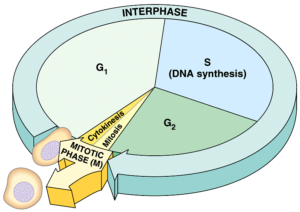Cell cycle
Overview of Mitosis
Stages of Mitosis
Prophase
Metaphase
Anaphase
Telophase
Cytokinesis
Uncontrolled cell division in cancer
Binary fission
Cell cycle
The cell cycle refers to the distinct stages through which a cell goes, from the moment it becomes a cell to the moment it divides to result in 2 separate cells. Bear in mind that some cells cease to divide any longer after a certain period of time, depending on cell type. If that’s the case, they are said to be in resting phase termed G0 .
Within the dividing cell, it starts with gap 1, G1 , continues into the S phase (S is for Synthesis) where DNA replicates , followed by gap 2, G2 , and ending with mitosis.
G1 and G2 may sound like codes for some complex enzymes, but they are mere notations for gaps 1 and 2, which are just that: gaps between mitosis and DNA replication (in the S phase) respectively. G1 through to G2 – that’s G1 , S phase and G2 – are all stages which collectively are known as interphase. Inter = between; phase = …phase, so interphase is just the stage between a cell’s creation and that cell’s division by mitosis.
Interphase is by far the stage in which most cells are in most of the time. The other stage, the small one, is called the mitotic phase and it encompasses mitosis (prophase, metaphase, anaphase and telophase) plus cytokinesis.

Overview of Mitosis
Mitosis is the process by which cells divide to achieve growth and repair by simply increasing cell number. The dividing cell is called the parent cell, and the resulting two cells have inappropriately been called daughter cells by scientists so far. Now because cells don’t have a damn gender and we are better than accepting silly nonsensical received wisdom about what to call these cells, we will call them offspring cells instead….
